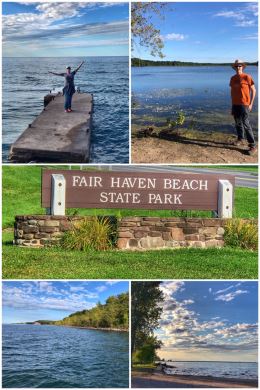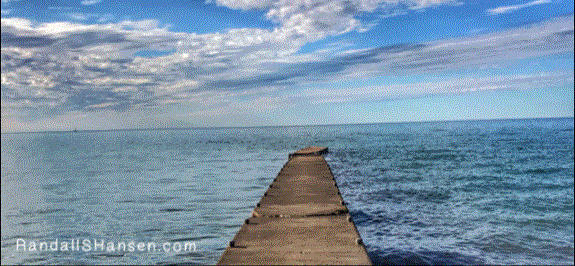
From the Niagara Falls area, we drove eastward, partly along the deserted (and dilapidated) Lake Ontario State Parkway and NY-104, somewhat following the shores of Lake Ontario through Rochester into Oswego… and to our wonderful little campground — Sunset RV Park –located across the street from the lake!
Lake Ontario is the fifth and final of the Great Lakes that we have been so fortunate to experience on this trip. Lake Ontario is the easternmost of the Great Lakes, the lowest in elevation at 243 feet, and the smallest in surface area at 7,340 square miles. It is the 13th largest lake in the world. In the Huron language, Ontarí’io means “Lake of Shining Waters.” Like the other Great Lakes, Lake Ontario was carved out by the Wisconsin ice sheet during the last Ice Age. (Fun fact: It is the only Great Lake that does not border Michigan!)
Besides walking along the shores of the lake near the campground and on the campus of SUNY Oswego, we also spent some time taking care of business in Oswego, a small city of about 18,000 folks. It calls itself “The Port City of Central New York.” We also visited Fort Ontario, a star-shaped historical fort located on the east side of the Oswego River on high ground overlooking Lake Ontario. Amazingly, the fort has been built and destroyed multiple times… the fourth and current Fort Ontario is an American version built during the Civil War on the ruins of three earlier fortifications dating to the French and Indian War (when the British built the first fort in 1755), Revolutionary War, and War of 1812. It opened as a state historic site in 1953 and is currently undergoing renovations. The grounds are open daily.

We later spent more time along the lake and in nature at the nearby Fair Haven Beach State Park, a 1,141-acre state park on the southeastern shore of Lake Ontario, and located about 14 miles southwest of Oswego. The park includes towering shoreline bluffs, sandy beaches, hilly woodlands, and inland water (including Sterling Creek and Pond).
We parked at Sabin Point, near the Lake Ontario sandy beach area and hiked the Bluff Nature Trail. Other trails in the park include the Lakeshore Trail and Woodland Trail. All of the trails are fairly short and manageable.
The park was wonderfully empty, but by the massive number of parking spaces, we know it must get crowded in the summers. The park also offers picnic areas, camping spots (46 electric sites and 138 non-electric sites), cabins, and boat rentals (only for use in the pond). It also includes a camp store, boat launch and marina, and an 18-hole golf course. In the winters, folks use the park for snowshoeing, cross-country skiing, and ice-fishing.
Fun facts about the park: The park was originally built by the Civilian Conservation Corps (CCC) between 1934 and 1942; the CCC men constructed buildings, created trails, created roads and parking lots, and planted trees. More interestingly, the park was later used to house German prisoners of war during its days as the Prison Camp at Fair Haven.
And that concluded the visit to Oswego and our last Great Lake.
Next up we head further east and to the Adirondack Region of New York.
